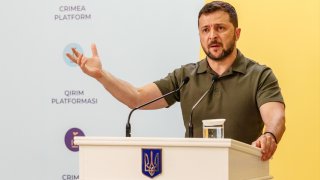Ukraine: The Day After
Rebuilding the country and breaking Russia’s stranglehold will require a massive infusion of private investment and across-the-board economic reforms.
President Trump is now officially the Republican Party’s presidential nominee and chose Senator JD Vance (R-OH) as his running mate. Last week, President Biden announced that he was dropping out of the 2024 presidential race. Now, all signs point to the strong prospect of new leadership in the White House come January.
One of the top foreign-policy priorities for the next president will be bringing the war in Ukraine to a peaceful settlement.
But what will happen to Ukraine after that?
Upon such a settlement, the reconstruction of the country would ensue. The World Bank estimates that it will cost half a trillion dollars to rebuild Ukraine. Ukraine says it needs twice that sum.
The only problem is that American taxpayers are, understandably, not eager to foot the bill. America has already committed roughly $175 billion to the war in Ukraine, not to mention the fact that Ukraine’s billions of dollars in war and prewar debts to U.S. and European bondholders are due. Pressure is mounting for Kyiv to start paying them back.
This may seem like a grim financial outlook on the surface, but it represents a historic opportunity for Ukraine. If Kyiv can adopt a post-war strategy that spurs high economic growth and breaks through the Soviet legacy that has saddled it with endemic corruption, crony capitalism, budget-draining state companies, and government mismanagement, it could help attract private capital, strengthen the country’s resiliency against future Russian attacks, and more firmly integrate it into Europe. The recent NATO Summit decision to include Ukraine under Europe’s security umbrella increases the prospects for more private investment.
Many will be tempted to simply throw foreign aid at the problem. But that won’t work. Recent recipients of donor reconstruction assistance, from Iraq ($220 billion) and Afghanistan ($145 billion) in Asia to Bosnia-Herzegovina ($2 billion) in Europe, all struggled to recover. Absent reform, little private investment followed as each country became dependent on foreign aid. Once the aid spigot was turned off, their economies collapsed.
Worse, Western aid agencies tend to rely on the World Bank to manage their projects. Chinese state-owned firms are the Bank’s largest contractors—earning “the most contract dollars,” according to a Government Accountability Office report.
Imagine the American reaction to having defended Ukraine only to enrich China, which backed Russia’s war machine. Make no mistake, Ukraine needs funding, and lots of it, but no country has transitioned from poverty to prosperity through foreign aid. In fact, in most cases, the opposite tends to happen, as massive aid flows disincentivize governments from making the free-market reforms required to attract foreign investment and spur economic growth.
That was the basis, for example, of the much (mis)cited post-World War II Marshall Plan. Former USAID administrator Mark Green reminds us that the Plan “was about much more than money” and required policies that promoted “private enterprise, competition, balanced budgets, stable exchange rates, and liberalized price controls” with “a definite sunset.” Those sunset clauses came into effect after four years, and Europe’s economy boomed thereafter, with massive foreign investment driving its post-war recovery.
Therefore, it is no secret what Ukraine must do to attract the private capital it needs to rebuild. The starting point is combatting corruption, which will be an uphill battle.
Ukraine has yet to liquidate its 3,500 state-owned enterprises that feed endemic crony capitalism, corruption, and massive budgetary deficits, sustaining anti-foreign investment lobbies fearing external competition. Kyiv, instead, wants to establish strategic state-owned monopolies, especially in the energy sector.
These policies reflect old Soviet-era habits of a government that still wishes to control the economy. By holding onto them, Kyiv signals to global equity markets that it is not serious about making market-based reforms to attract foreign investment. This stance will likely starve Ukraine of the foreign financing it needs to rebuild.
Should Kyiv move to privatize these companies, however, and remove regulatory burdens and decrease its high taxes, it could unlock substantial private capital, especially in its competitive agriculture, energy, technology, and now defense sectors. In 2021 alone, and during wartime, Ukraine saw over $18 billion in remittances from millions of Ukrainians working in the West in 2021. Improve the business climate, and more money will follow, not to mention integration into European markets and commercial independence from Russia.
It won’t be easy, of course. Post-war reforms are politically difficult, as powerful domestic leaders often fight to maintain their privileges. But if Ukraine’s leadership doesn’t make major changes, European companies could choose to compete for risk-free donor-funded reconstruction contracts rather than risk their own capital. Likewise, global private equity will look elsewhere to invest. Even many Ukrainians might hold onto their money and seek new lives in a Europe eager to attract an educated workforce.
Kyiv needs to come to grips with these hard reforms now. If Ukraine’s leaders don’t embrace the reality that any real reconstruction will come from private—not public—coffers, they will miss the historic opportunity to break free from Russia’s economic orbit.
Max Primorac, senior research fellow at the Margaret Thatcher Center for Freedom of the Heritage Foundation, was former deputy director of the U.S. government’s $23 billion reconstruction program in Iraq. More recently, he served as Acting Chief Operating Officer at the USAID.
Image: Yanosh Nemesh / Shutterstock.com.

